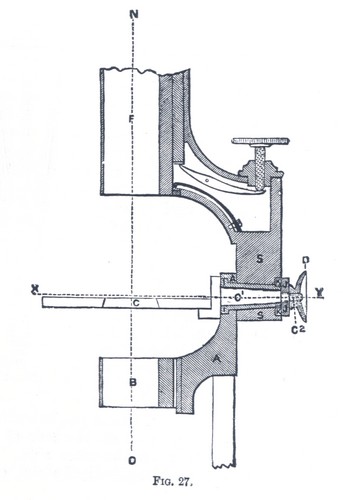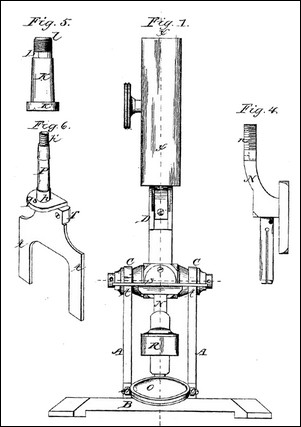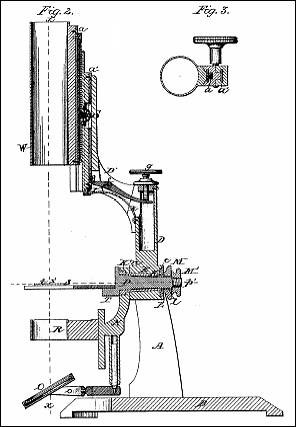







Accessories include three objectives, five eyepieces (two pairs for use as a binocular), diaphragm wheel, condenser with diaphragm wheel, analyzer, polarizer, objective-mounted side reflector, stage forceps, live-box, compressor, and additional filters and fittings.

The American Centennial
binocular model microscope was first exhibited by
Joseph Zentmayer (1826-1888) at the Centennial
Exposition in Philadelphia in 1876.
Another later
example of this model with serial number 2504 is
also represented in this collection. It differs
primarily from the example on this page in having a
centering sub-stage. The binocular American Centennial is
rather uncommon. As quoted by S. H. Gage in
Microscopy in America (1830-1945), 1964 in a
letter dated 1938 from Arthur H. Thomas (a Philadelphia
instrument supplier) to H. N. Ott of the Spencer Lens
Co. in reference to the binocular version of this
microscope, it was stated that "there were
forty-four of these instruments made in all, and they
are now museum items". So far, only a fraction of
these are known to have survived.
The American Centennial
binocular model microscope is considered by many the
finest and most influential American microscope
manufactured in the 19th century. Prior to
the introduction of the American Centennial, the
Grand American model was the
top-of-the-line microscope produced by the firm.
The Aug. 15, 1876 patent describes the
fine adjustment mechanism and a novel swinging substage
which allows extreme oblique illumination (it could
even swing above the stage thus allowing illumination
from above). The swing was designed so that the
condenser and mirror would remain in focus on the
specimen at any angle. This type swinging sub-stage
became very popular. It influenced the manufacture of
new models made both in America and in England (e.g.,
the
Ross-Zentmayer models, the
Beck International model, etc.)
See the article written by Zentmayer entitled "What I Know About Late Improvements of the Microscope" published in the Journal of the Franklin Institute, LXXXIV, 1877
The following was extracted from the 1895 Zentmayer catalog
AMERICAN CENTENNIAL STAND

THIS
Stand was originally designed and constructed in 1876
and shown at the Centennial Exhibition in
Philadelphia. It is made entirely of fine brass of the
best finish, and is full nineteen inches high when
arranged for use. It is mounted on a circular platform
revolving on a tripod base, beveled silvered and
graduated in degrees for measuring the angular
aperture of objectives. Upon this platform two pillars
are planted, between which the bar and trunnions in
one piece swing, allowing the instrument to be
inclined to any angle.
The coarse adjustment is effected by rack and pinion. The
arm carrying the body is provided with two adjacent
slides, the upper and longer one bearing the tube with
rack and pinion movement, and sliding in the lower
one, which is lifted by a lever of the first order,
actuated by a milled-headed micrometer screw in
convenient position at the back of the instrument. At
the bottom of the lower slide there is a shoulder
against which the lever acts, and a spring above
presses this shoulder down, insuring its continuous
contact with the lever during adjustments. All the
mechanism is contained within the arm, which is so
hollowed as to secure both lightness and greater
rigidity. This fine adjustment was originally invented
by Joseph Zentmayer and first introduced on this
instrument. It is absolutely free from lateral motion,
and exceedingly sensitive. Its construction prevents
wear, and is so positive that a revolving nose-piece
and attached objectives can be easily carried without
injury. It also acts as a safety appliance in case an
objective is accidentally racked down against an
object, for the spring yields quickly to upward
pressure. The fine adjustment, in all other
instruments of the Jackson model placed in front of
the body, is thus removed to the most convenient and
stable part of the instrument; the body is not touched
directly in focusing, and the relative distances of
Objective, Binocular Prism, and Eye-piece remain
constant.
It has
been criticized that the micrometer screw in this fine
adjustment has to bear the entire weight of the body
just as in the Continental models, but not in
accordance with the facts. The lever varies in length,
and the fulcrum is placed according to the size of the
instrument. One arm of the lever is about five times
longer than the other, whereby the weight of the body
and the motion imparted is reduced in the same ratio.
Time has vindicated its efficiency and practicability,
and the same plan is now used by most of the
well-known manufacturers.
The tail-piece carrying the sub-stage for illuminating or
other apparatus and the mirrors can be swung around a
pivot behind the stage, of which the axis passes
through the object observed, so that in every position
it is in the focus of the illumination. This important
arrangement, without which no microscope can be
considered complete, is carried out in a simple and
substantial manner. Although having only a single
joint, it admits of being swung over any of the
stages, from either side, and a complete revolution is
only prevented by the body of the instrument. A
graduated circle on the upper collar registers the
degree of obliquity, and a stop indicates when it is
central and parallel with the body.
As an
object placed on the stage is in a plane with the axis
of the trunnions, it is obvious that, if the
instrument is placed in a horizontal position, the
object is in the axis of revolution of the graduated
platform, and the angular aperture of an objective
focused on this object can be easily measured. It is
equally obvious that in this position the object is in
the centre of all rotation of the instrument, the
revolving stage and platform and the swinging
sub-stage.
It is
also apparent that the parts of the instrument are
distributed proportionately on each side of the
trunnion joint as an axis of inclination, so that when
horizontal the body and its accessories on one side of
the perpendicular passing through the stage and
supporting pillars are balanced by the sub-stage and
its accessories on the other side, whereby perfect
stability is secured.
The
principal stage was devised in 1862. It consists of a
bell-metal ring, firmly attached to the bar, but
adjustable by means of set-screws, to be perfectly
concentric to the optical axis of the instrument. This
ring receives the stage platform, which makes a
complete revolution. The outer edge is beveled,
silvered and graduated into degrees to serve as a
goniometer. The carrier for the object rests on
plate-glass, kept by a spring and ivory-pointed screw
in sliding contact on the two rails on the stage
platform, which arrangement gives an exceedingly
smooth and firm movement and a freedom of motion not
obtained in any other way.
Owing
to its simplicity, convenience and durability, this
stage has been extensively copied at home and abroad.
The stage may be easily detached by simply unscrewing
the nut at the back of the bar and another
substituted, as, for instance, a plain or mechanical
one.
A
mechanical stage, revolving, graduated and adjustable,
can be furnished at an additional cost of $40. It is
five inches in diameter; the lateral movement of 1 1/4
inches is accomplished by a screw, and the
longitudinal movement of 1 1/8 inches by rack and
pinion. Although very rigid and steady, it is
extremely thin, admitting an obliquity of full 70°.
All stages are reversible on the stand, thus admitting
unlimited obliquity and retaining the object always as
the centre.
The
sub-stage is divided into two cylindrical receivers,
to facilitate the adaptation of several accessories at
one and the same time. The upper cylinder has perfect
centering adjustment and the lower cylinder can be
moved up and down or entirely removed.
The
Wenham Binocular body has been adopted because of its
simplicity, good effects and ready convertibility to a
Monocular Instrument, but its mechanical arrangement
has been materially improved so as to diminish some of
the defects necessarily involved in the principle.
1. American Centennial Stand, Binocular; five Oculars; 8/10 inch Objective, 0.28 N. A. and i-inch Objective, 0.87 N.A., adjustable,.....$258.00
2. American Centennial Stand, Monocular; three Oculars ; same Objectives as No. 1,.....$218.00
3. American Centennial Stand, Binocular, with five Oculars, $225.00
4. American Centennial Stand, Monocular, with three Oculars, $185.00
Each Centennial Stand is provided with a fine Mahogany Case, with handle, and side case for accessories.
The Zentmayer 1876 patent describes the fine adjustment mechanism and the new swinging sub-stage.
The design of the swinging substage was fully described in Hogg, The Microscope, 14th Edition as follows:
\
Swinging Sub-stage, or Tailpiece.- The Swinging sub-stage, although revival of an invention contrived by Mr. T. Grubb some twenty years ago, has been very generally adopted, since it is thought by manufacturers to be an important and useful addition to the more perfected forms of instruments. This tailpiece, represented in sectional elevation fig. 27, consists of S, the limb carrying the body, with coarse and fune adjustments; A, the stem carrying the sub-stage, B, and mirror. A is attached to S by the sleeve or socket I,. clamped by the nut J, and on I A may be swung sideways in either direction to the right or left, either below or above the stage, the axis of revolution which is the line X Y; that is, a line in the plane of the object to be viewed on the stage C, intersected by the optical axis of the instrument; that is, the line N O, passing through the centre of the body and the objects glass of the microscope The stage C is also attached to S by the pin C1, terminated by the screen C2, which pin passes through the contre of the socket I, and moves therein so that the stage C may readily turn in either direction in conjunction with or independent of A, the axis of its revolution being also the line X Y. By this kind of arrangement the stage C and the stem A can be set at any angle to the axis of the microscope, either below or above X Y, intersecting the plane of the object to be viewed, and relatively to each other, and when so set the stage C can be clamped at the desired angle by the nut D on the screw C2 acting on S and the collar K.



Biographical Sketch of Joseph Zentmayer
See this article from: Proceedings of the American Microscopical Society. Vol. 14, No. 3, 1893.

